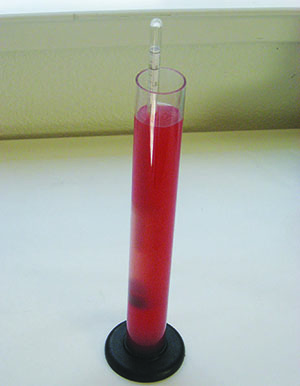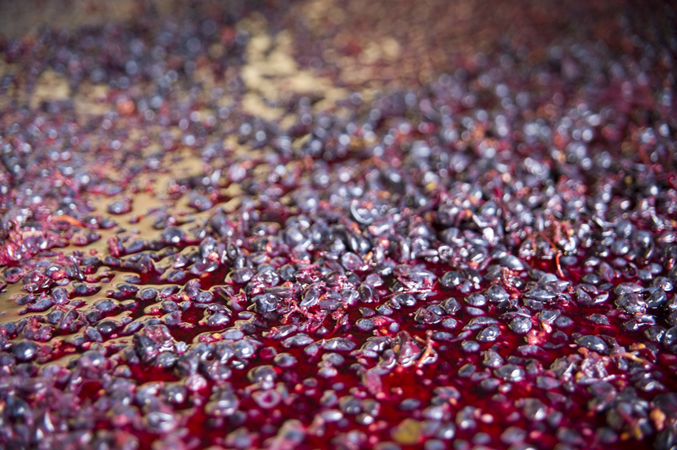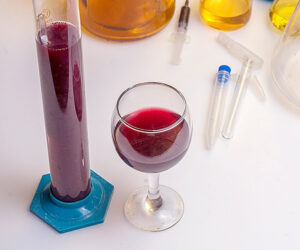It’s hard to dispute that winemaking is an art. And it’s no surprise that winemakers sometimes act like artists. Now imagine, if you will, a room full of artists who meet to discuss a problem with a paint that they all use. The problem is that near the end of any given painting, this paint sometimes changes colors. Pretty often, in fact. So what is an artist to do when the chairperson asks, “Who has recently had this problem?” Sure, it’s easy to raise your hand if your work isn’t so great, because then you have an excuse. But what if a magazine just raved about it and you had a different color in mind when you started?

None of the winemakers at a recent conference on stuck fermentation raised a hand. Sure, they may have come to the meeting, but that doesn’t mean they actually had a stuck fermentation or anything! After a while most admitted that there was this little, unimportant tank in the corner…
Winemaking egos aside, stuck fermentations are a real problem. Don’t worry if it happens to you at home, because it happens to professional winemakers all the time. Even if you don’t hear about it. There are steps you can take to lessen the chances of a stuck fermentation (or to increase them, if you want a sweet wine!) and there are techniques to restart a fermentation once it’s stuck.
There is also another approach for home winemakers that is not always an option for professionals. You might call it the Taoist approach. If you get a stuck fermentation, you could just go with it and make a sweet wine or port. Tell your friends that the juice is like an uncarved block of granite that contains the nature of the wine; the yeast cells will chisel what they will. A little polishing won’t hurt, though, and we’ll touch on some of the winemaker’s options.
Why It Matters
During fermentation, yeast cells consume sugar. There are two major reasons that sugar levels are important in a finished wine. One, of course, is how they affect flavor. Most sugars are sweet, and all of them increase the body of a wine. But an equally important consideration is that any residual sugar could potentially be fermented after bottling. So if you make (or the yeast chisel) a sweet wine, then your biggest concern is microbial stability. If you are making a dry wine, on the other hand, your biggest concern is that the fermentation shouldn’t stop before all the sugar is consumed.
Sugar and Wine
There are several different kinds of sugars found in wine. Grapes contain mostly glucose and fructose in about equal amounts. They have six carbons, so they’re called hexoses. Yeast cells ferment both glucose and fructose but generally consume glucose faster than fructose. You can add sucrose (table sugar) to juice because, molecularly, it’s just a fructose connected to a glucose, which yeast cells easily split apart and then ferment. There is a small amount of pentoses in juice that will eventually comprise about a third of the sugars in afinished wine. These five-carbon sugars aren’t sweet and are not fermentable by yeast but show up in one common type of analysis test described later. Some types of bacteria found in wine can grow on pentoses, so their presence can contribute to wine instability.
The residual sugar levels in wine range from almost nothing to about 10 percent, so there is plenty of room to suit your taste. A “dry” wine traditionally has less than two grams per liter (about 0.2 percent) of sugar. Any wine containing greater than about 2 percent residual sugar tastes obviously sweet.
Analysis
The way to measure residual sugar is not with a hydrometer. Hydrometers measure density, which in a finished wine is a function of the alcohol concentration and the dissolved material (soluble solids). The vast majority of dissolved material at the beginning of fermentation is sugar, and there isn’t any alcohol yet. So density is a pretty good estimate of sugar concentration at the beginning. But toward the end of fermentation, the alcohol concentration of two wines might be 12 percent and 14 percent and they might have the same residual sugar, but the densities will be completely different. This occurs because alcohol is less dense than water. So don’t use hydrometers to measure residual sugar!
Kits for measuring residual sugar are readily available and were developed for measuring sugar levels in blood and urine. The test procedures are simple and consist of one of three options:
- adding a pill to a specific number of drops of wine and comparing the color to a chart;
- dipping a test strip in the wine and comparing the color; or
- dipping a test strip and using a machine to read it. Check with your local winemaking shop or pharmacy.
If you choose the test strips, use a color test rather than buy an expensive machine to read them. Expect to pay about 50 cents to $1 for each test strip. Many winemakers use Clinitest brand tablets, which cost about $20 for a box. There are two basic types of tests. One is a chemical test in which sugars are oxidized by something that changes color and measures all reducing sugars, both hexoses and pentoses. Clinitest tablets are this type. The other is an enzymatic test that measures only glucose.
Be careful with tablets that measure reducing sugar because many contain sodium hydroxide, which can burn you. The tablets are also poisonous. Open the individual pills right before you use them. The enzyme test strips might have an expiration date and might need to be stored in the refrigerator. As always, follow the manufacturer’s directions.
Avoid Sticking
Prevention is the best medicine for stuck fermentations, because they can be extremely difficult to restart. There are several possible causes of a stuck fermentation, but winemakers have found that a few precautions guarantee (almost) that your fermentation completes. Most often, yeast cells quit for one of these reasons: membrane woes, nutrient deficiency, or they’re poisoned. The first two are probably easier to prevent than the last one. Some chemicals used on grapes can poison yeast, so if you notice a consistent problem with grapes from a particular vineyard, tell the viticulturist!
Keep the temperature of fermenting wine constant. Temperature swings are probably the biggest cause for stuck fermentations. A shift of only 5 to 9° F (15° C) up or down can be enough to do it. The effect becomes more drastic as alcohol content increases, so be especially careful at the end of fermentation. This has to do with temperature and alcohol effects on the cellular membrane.
Rehydrate dried yeast in water, not must or wine, for about 15 minutes before pitching. The drying process destroys the integrity of the cellular membrane, which needs to be re-established before the yeast is tossed into the harsh wine environment.
Test your must before fermentation to ensure that there is not too much sugar and make sure the titratable acidity (TA) and pH are properly adjusted. Many yeast strains can’t ferment much beyond 14 percent alcohol, so keep your must Brix reasonable — lower than about 25° — and you should be safe. If the pH falls too low (lower than 3.2), the yeast cells become inhibited. If it becomes too high (higher than 3.9), then other microbes can cause problems.
Give the growing yeast their vitamins! Generally, must is not nutrient deficient, but any mold on the grapes could deplete essentials. Just to make sure your yeast remains strong, add some yeast nutrient or lysed yeast for vitamins and amino acids. Also, use yeast hulls (also called yeast ghosts) to provide essential fatty acids. Check with your local home winemaking shop for more information about nutrient supplements.
Use 30 parts per million (150 mg per 5 gal., or 18.9 L) sulfur dioxide at press. There are hundreds of bugs growing on grapes, and many of them gobble up nutrients faster than your yeast. Some others actually produce toxins that inhibit or kill yeast. The sulfur dioxide will stall them. This is particularly crucial if you cold soak the grapes before fermentation, because another type of yeast (an unfriendly type, mind you) called Kloeckera loves the cold and gobbles up important nutrients in this environment. Also, sulfur dioxide inhibits enzymes that quickly consume oxygen, which is required by yeast cells to maintain healthy membranes.
Here’s a trade secret, so please keep it quiet. Oxygenate the must when it’s about 7 percent ethanol. For a seven-day fermentation this occurs about day three. There are several ways to oxygenate, and probably the most efficient is to use an aquarium bubbler with a porous dispersion stone on the end of the hose. Not very much oxygen is needed, so only bubble for a few minutes.
There are a few different ideas about why this works. One is that at this stage there is enough alcohol that most other bugs (and enzymes) have died. So your yeast gets all the oxygen before something else gobbles it up. Another theory is that this is the beginning of the stationary phase of the yeast lifecycle, and perhaps the changes in metabolism make oxygen important at this point.
Finally, a wild and screaming fermentation dance doesn’t hurt. Just be sure to pitch the yeast before you get too crazy.
Restarting
So what happens if all those precautions didn’t work? (You forgot the fermentation dance, didn’t you?) Restarting is certainly an option, but really, you don’t want to do this. Sure, there is a certain amount of pride associated with producing your work of art, but have you considered Taoism? If the wine is not too sweet, then just polish it up or fortify it and skip this torturous topic completely!
If you’re bent on restarting your fermentation, then here is a procedure that often works.
- Check the wine. If the alcohol content is already above 14 percent, then you might have to use a yeast strain that is tolerant of high ethanol content. Of course you properly adjusted the TA, pH, and sulfur dioxide before fermenting, but if not then you’d better do it now! Add some nutrients just to be sure.
- Reinoculate. Make sure your yeast is fresh, properly hydrated, and pitched into wine at room temperature.
- Splash and swirl the wine around in your fermenter. Do this a couple of times a day for a few days. Why does this work? Maybe it has to do with mixing nutrients. Maybe it volatilizes certain small fatty acids that inhibit yeast.
- If the yeast hasn’t started yet, then start another fermentation. Prisse de Mousse, with few nutrients, ferments anything to dryness. When it is actively fermenting, add some of the stuck wine to twice the amount of the new fermenting wine (but don’t use all the new stuff). If it keeps fermenting, then keep adding half amounts of stuck wine every two days. If it doesn’t keep fermenting, then try it again with the saved fermenting wine and use even smaller amounts of the stuck wine. When primary fermentation is complete, add Luecofood or Vitamix to encourage malo-lactic fermentation to finish. Yeast hulls and superfood will not help malo-lactic fermentation; they are useless to the bacteria, which don’t use inorganic nitrogen.
Polishing
Maybe you’re here by choice, maybe you’ve surrendered. At any rate you have a sweet wine that needs to become drinkable and microbially stable. There are three ways to stabilize a wine: Sterilization, fortification, and chemical addition.
Sterilization is the most effective method, but it also requires the most handling. If your wine tastes good already and you don’t mind the work, it’s probably the best option. The most common way to sterilize a wine is to filter it through a 0.45-micron filter into sterile bottles.
The other option is pasteurization, in which the wine is rapidly heated in small amounts to 176° to 194° F (80° to 90° C) and then rapidly cooled. One effective way to do this is to bottle the wine (don’t cap or cork yet!) and heat the bottles quickly in boiling water, then allow them to cool in ice water. This works best in small bottles (375 mL). One problem with pasteurization is that it can cause unsavory cooked flavors and aromas. Sterile filtration is better.
Fortification is a good option when your wine could use some tweaking to improve the taste. Any wine above 20 percent alcohol is quite stable, so use that as a target. Unfortunately it’s not easy to measure alcohol with lots of residual sugar, so just wing it: Use one part spirits (40 percent alcohol) to three parts stuck wine (about 10 percent alcohol). Try several different combinations of stuck wine, spirits, and sugar to find the one that tastes the best, but don’t use much less than one-third spirits unless your wine is fairly dry. This is also a great way to stop a fermentation to make a sweet, fortified wine on purpose.
Finally, there are several chemical stabilizers available, but they provide the least amount of protection. Potassium sorbate can be used to prevent a yeast population from growing, but it won’t kill the yeast cells. It will only help to prevent a new bloom of yeast cells, not stop them. Also, some spoilage microbes can exist in the presence of potassium sorbate, and potassium sorbate can cause an odd floral aroma. Keeping sulfur dioxide levels properly adjusted also helps, and adjusting sulfur dioxide is generally a better choice than adding potassium sorbate.
However, the choice depends on the wine and equipment you have available.
Understanding residual sugar can give you lots of flexibility for creating wine. Stuck fermentations play a central role and can be prevented or used to your advantage. So with that, may you never have to attend a stuck fermentation conference! Unless, of course, you’re just going for the cheese and crackers.




